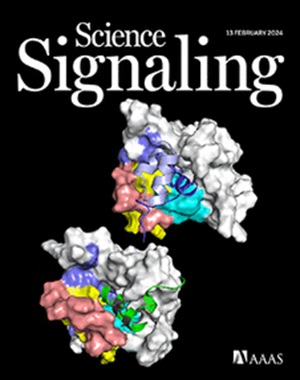ERK激酶在胰腺癌细胞上皮-间质转化的异质性中起保守的主导作用
IF 6.6
1区 生物学
Q1 BIOCHEMISTRY & MOLECULAR BIOLOGY
引用次数: 0
摘要
上皮-间质转化(EMT)在癌细胞中发生异质性,促进化疗耐药。识别所涉及的信号通路将提名药物组合来促进化学反应,但细胞群体水平的研究可能会产生误导,单细胞转录组学仅限于基于本体的间接推断。为了了解信号蛋白水平上EMT的异质性,我们结合了胰腺癌细胞和肿瘤的迭代间接免疫荧光成像和互信息(MI)分析。首先关注有丝分裂原激活的蛋白激酶途径,MI指出ERK活性的细胞间差异决定了EMT对不同生长因子和化疗药物反应的异质性,但当MEK被抑制时,JNK会进行补偿。人口水平的模型不能捕获这些实验验证的MI推断。即使将分析扩展到包括7个潜在的emt调节信号节点,MI也一致表明ERK的主导作用。更一般地说,这项工作提供了一种在任何环境下基于蛋白质测量研究多变量信号-表型关系的方法。本文章由计算机程序翻译,如有差异,请以英文原文为准。
The kinase ERK plays a conserved dominant role in the heterogeneity of epithelial-mesenchymal transition in pancreatic cancer cells
Epithelial-mesenchymal transition (EMT) occurs heterogeneously among carcinoma cells to promote chemoresistance. Identifying the signaling pathways involved will nominate drug combinations to promote chemoresponse, but cell population–level studies can be misleading, and single-cell transcriptomics are limited to indirect ontology-based inferences. To understand EMT heterogeneity at a signaling protein level, we combined iterative indirect immunofluorescence imaging of pancreas cancer cells and tumors and mutual information (MI) analysis. Focusing first on mitogen-activated protein kinase pathways, MI indicated that cell-to-cell variation in ERK activity determined EMT heterogeneity in response to different growth factors and chemotherapeutics but that JNK compensated when MEK was inhibited. Population-level models could not capture these experimentally validated MI inferences. The dominant role of ERK was consistently indicated by MI even when the analysis was expanded to include seven potential EMT-regulating signaling nodes. More generally, this work provides an approach for studying multivariate signaling-phenotype relationships based on protein measurements in any setting.
求助全文
通过发布文献求助,成功后即可免费获取论文全文。
去求助
来源期刊

Science Signaling
BIOCHEMISTRY & MOLECULAR BIOLOGY-CELL BIOLOGY
CiteScore
9.50
自引率
0.00%
发文量
148
审稿时长
3-8 weeks
期刊介绍:
"Science Signaling" is a reputable, peer-reviewed journal dedicated to the exploration of cell communication mechanisms, offering a comprehensive view of the intricate processes that govern cellular regulation. This journal, published weekly online by the American Association for the Advancement of Science (AAAS), is a go-to resource for the latest research in cell signaling and its various facets.
The journal's scope encompasses a broad range of topics, including the study of signaling networks, synthetic biology, systems biology, and the application of these findings in drug discovery. It also delves into the computational and modeling aspects of regulatory pathways, providing insights into how cells communicate and respond to their environment.
In addition to publishing full-length articles that report on groundbreaking research, "Science Signaling" also features reviews that synthesize current knowledge in the field, focus articles that highlight specific areas of interest, and editor-written highlights that draw attention to particularly significant studies. This mix of content ensures that the journal serves as a valuable resource for both researchers and professionals looking to stay abreast of the latest advancements in cell communication science.
 求助内容:
求助内容: 应助结果提醒方式:
应助结果提醒方式:


